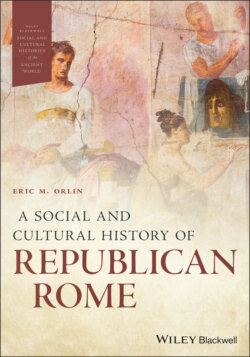Читать книгу A Social and Cultural History of Republican Rome - Группа авторов - Страница 31
Marking Time
ОглавлениеIn placing the end of the Republic in 31 BCE, we have performed one of a historian’s most characteristic activities: dividing history into periods. Typically these divisions are based on characteristics that historians believe are common to this period. For instance, the medieval period, lying between the Roman Empire on the one side and the Renaissance on the other, is often characterized as having significant authority vested in religious officials. Larger periods, such as the Roman Republic that lasted for 500 years, are often divided into smaller units as well, and the process of deciding where to place the breaks forces us to think about larger trends in Roman history rather than the details of individual episodes.
Historians of ancient Rome have tended to divide its history into three broad phases based on the form of its government: the Monarchy (753–509 BCE) from Romulus to Tarquin; the Republic (509–31 BCE), when power was vested in magistrates elected by the citizen body; and the Empire (31 BCE–476 CE) following the battle of Actium, where power was again vested in one man. Other divisions are possible: one could use territorial control as the criterion and divide Rome’s history into an early period as a city-state (753–338 BCE); a middle period as a world power (338 BCE–260 CE), lasting until the emperor Valerian was captured in battle; and a late period when Rome’s power was in decline (260–410 CE or 546 CE), ending with the sack of Rome by a foreign army. For simplicity’s sake we will stay with the traditional divisions in order to keep our focus on the period of the Republic.
When we try to divide the Republic into smaller periods, we run into problems similar to those just mentioned. Modern historians have generally divided the Republic into three periods – historians seem to like the Early, Middle, and Late formula. The challenge has been that it is not always easy to find unifying characteristics or agreed end-points for all three periods, such that new divisions have been proposed. For instance, Harriet Flower has kept the idea of using political systems as the criterion for defining periods, but suggested that the period from 509 to 33 BCE should be divided not into three, but into thirteen separate periods. She identifies five different forms of government between 450 and 88 BCE, each using the principle of government shared by leading citizens but operating in a slightly different fashion. She identifies a further four “transitional” periods with no clear government principles, two periods of Triumvirates (rule by three men), and a period of one-man rule in the dictatorship of Julius Caesar. In this book we will stick for simplicity’s sake with the traditional division into an Early Republic (509–287 BCE), Middle Republic (287–133 BCE), and Late Republic (133–31 BCE), but we should recognize that these periods are defined by historians and that some of the markers may be more useful for conversation than reflective of real changes in the Roman state.
